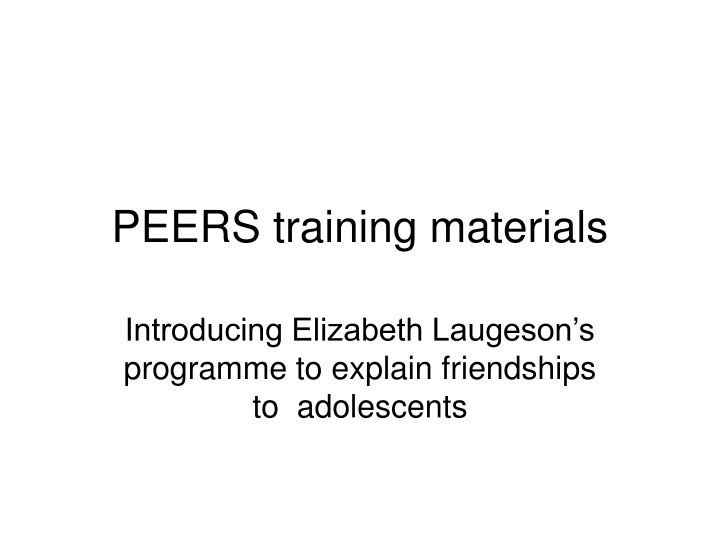Introducing PEERS Programme by Elizabeth Laugeson: Helping Adolescents Understand Friendships
Learn about the PEERS programme designed by Dr. Elizabeth Laugeson and Professor Fred Frankel to support adolescents, particularly those with social interaction difficulties like ASD, in making friends. The course aims to educate on PEERS, identify beneficiaries, differentiate from other programmes, and enhance confidence in discussing social rules with young individuals. Discover how the programme works, who can benefit from it, and its evidence-based approach using questionnaires for assessment. Explore the manual, book, and home-use resources to foster relational skills in adolescents.
Download Presentation

Please find below an Image/Link to download the presentation.
The content on the website is provided AS IS for your information and personal use only. It may not be sold, licensed, or shared on other websites without obtaining consent from the author.If you encounter any issues during the download, it is possible that the publisher has removed the file from their server.
You are allowed to download the files provided on this website for personal or commercial use, subject to the condition that they are used lawfully. All files are the property of their respective owners.
The content on the website is provided AS IS for your information and personal use only. It may not be sold, licensed, or shared on other websites without obtaining consent from the author.
E N D
Presentation Transcript
PEERS training materials Introducing Elizabeth Laugeson s programme to explain friendships to adolescents
Aims of the course To learn about the PEERS programme To identify pupils who may benefit To increase understanding of how PEERS differs from other programmes To gain confidence in how we speak to young people about unwritten rules of social interaction To consider how it could be used in your school
What is the PEERS programme? Dr Elizabeth Laugeson - clinical psychologist from U.C.L.A Carried out research with Professor Fred Frankel to find most effective techniques to support adolescents with social interaction difficulties (including ASD) to make friends PEERS Manual for pupil, staff and parents and The Science of Making Friends 2013
What is the PEERS programme ? Program for the Evaluation and Enrichment of Relational Skills Original programme is for 14 sessions where two groups are facilitated, one for pupils and one for parents who are trained as coaches New book is for home use divided into 13 hands-on sections supported by a DVD of video demonstrations
Who may benefit? Materials are aimed at adolescents who want to learn how to make and keep friends E.L found 55% of pupils were more or less accepted by their peers with 15 % being popular 30% of pupils experienced either peer rejection or social neglect
Who may benefit ? Peer rejection (15%) actively seek out friends but are perceived as weird , hyper verbose. Make unfunny jokes, monopolise conversations and are rejected. May get a bad reputation as being odd. Socially excluded (15%)-shy,withdrawn and rarely speak in social situations. May experience depression, anxiety and can go unnoticed Being alone also makes you vulnerable to bullying
How PEERS is different PEERS is evidence based. Baselines and results were evaluated using questionnaires that can be used in school to measure outcomes Test of Adolescent Social Skills Knowledge * (TASSK) Quality of Play Questionnaire for parents and adolescents (QPQ-P) (QPQ-A)*
How PEERS is different It is based on what really works ecologically valid Works alongside the student in partnership Builds on their strengths e.g. uses rules to structure up social interaction Uses key phrases to act as reminders and affirmations e.g. Friendship is a choice It can be supported by a mobile phone app Not a buddying system
So how does it do it? Find students who want to learn Students need to be aware of their own anxiety levels - we have the Anxiety Programme in MK that we can use first Begin by considering students own interests Then observe the social interactions around you-identify a group where you may find like-minded people
Who is out there ?? Activity identify at least 10 groups of teens
How can I make him my friend? Friendship is a choice Programme is about reality and will not promise to make everything easy. Lessons about humour feedback to help students realise when they are being laughed at rather than with How to read gaze aversion and what that means and how to withdraw from situations
How would it look in my school? 14 sessions with parents too is a huge commitment Programme could be divided into two parts each of 8 sessions just with students Part 1 Developing and maintaining friendships Part 2 Handling rejection and conflict
To begin.. Ask class tutors and mentors to identify possible students Meet with students individually to explain what it is about have a flyer for students and families explaining what it is about Identify a room that will be available and time that colleagues will accept you removing pupils Facilities to share DVD
Set up Complete the questionnaires so you can evaluate the intervention ( Specialist Teaching Team can supply templates) Perhaps invite families to an information session
Part 1 Finding and choosing good friends Good conversations:The basics Starting and entering conversations Exiting conversations Managing electronic communication Showing good sportsmanship Enjoying successful get togethers Celebration session
Part 2 Revisit Part 1- share emotional toolkit tips Dealing with rejection-teasing and embarrassing feedback Bullying and bad reputations Changing a bad reputation Handling disagreements Rumours and gossip Celebration
References TASSK- Modification of the Test of Social Skills Knowledge (Frankel,F.,Erhardt,D.,Renenger,K.,&Pataki,C.,2009)by permission of authors QPQ-P & A-Adapted from Frankel & Mintz(2008) by permission of authors























